War Memorial Hospital
Acute
The Waltham Abbey War Memorial Cottage Hospital was officially opened in December 1921 by Prince Henry. Paid for by public donations and erected as the town's war memorial to those killed during WW1, it had 8 beds.
The Hospital's Board of Governors consisted of 12 people - 6 men and 6 women.
The Hospital dealt with surgical cases - removal of tonsils and adenoids, appendicitis, gynaecological disorders, fractures, cuts, etc - and general medical cases - lung and gastrointestinal diseases. Along with other cottage hospitals, it did not admit persons afflicted with alcoholism, mania, epilepsy, or infectious or contagious diseases. If, for any reason, a woman in an advanced state of pregnancy was admitted, she was not detained. Visiting times were on Wednesdays and Sundays. However, for children and those on the danger list, visiting was at Matron's discretion.
In 1932 the Hospital was closed for six weeks while an extension was built at the cost of £2,650 (excluding the extra equipment and furnishings). The Hospital then had 16 beds. The women's ward had been increased to 5 beds (the men's ward was not altered). The new children's wards, with 3 beds and 4 cots, had their own bathroom. A room for a private patient had also been added. The average stay of an in-patient was 10 days, and the average weekly cost per patient was £4 15s 3s (£4.76).
The new staff quarters included a sitting room for the Matron and a dining/sitting room for the nurses; each had a separate bedroom.
A new Out-Patients Department with a Casualty Department and an X-ray Department had been built. The waiting hall of the Out-Patients Department contained the Memorial Tablet of the names of the fallen in the Great War in whose memory the Hospital was erected.
During WW2 the Hospital joined the Emergency Medical Service with 16 beds. As did other hospitals, there were difficulties due to staff shortages as members enlisted for active service. In December 1941 a First Aid Post for use by the Civil Defense for anticipated civilian casualties was built by the Ministry of Health. Four of the 16 beds had to be closed to accommodate it. The Hospital paid £500 towards the costs on the agreement that it would become Hospital property when the war was over. It was opened by Dr W.A. Bullough, the Medical Officer of Health for the County of Essex.
In 1945 a Victory Thanksgiving Garden Fete was held to celebrate the end of the war.
In 1947 the Hospital had 16 beds, 3 of which were closed while a new extension was built. In 1947 the weekly cost of an in-patient was £8 15s 11d (£8.80), compared to £6 6s 6d (£6.32) in 1946.
The new building was opened in January 1948 by Col. Richard Beale Colvin, Deputy Lieutenant for Essex. It contained the First Aid Post, which had been converted into a ward with 8-10 beds (but because of the shortage of staff it could not be opened until October 1949); a private patient's room fitted with a wash basin, telephone and an en-suite bathroom; and 6 extra staff bedrooms, with washbasins in each rooms and a bathroom attached. The work had cost £5,719, including the £500 paid to the Ministry of Health.
The Hospital then had four wards, each named after ancient personalities associated with Waltham Holy Cross - King Harold, Queen Eleanor, Queen Elizabeth and Hereward the Wake. However, delay in delivery of outstanding equipment and the furnishing of the wards (the latter paid for eventually by the Waltham Abbey Amateur Theatrical Society), and the lack of nursing and domestic staff, meant that the Hospital could not be used to full capacity. When fully staffed it would have 24 to 26 beds. Members of the Essex 16 British Red Cross Society Women's Detachment and the Essex 7 Men's Detachment provided some assistance to keep the Hospital functioning.
The Hospital joined the NHS in July 1948 under the control of the Epping Group Hospital Management Committee, part of the North East Metropolitan Regional Hospital Board. It dropped the word 'Cottage' from its title.
Its facilities for out-patients were quite inadequate and the Regional Hospital Board made plans to build a new Out-Patients Department, which would also include facilities for physiotherapy and minor surgery (including an anaesthetic room and surgeon's changing room), as well as consulting rooms, offices, a waiting room and toilets.
By 1950 it was a GP hospital with 24 beds, admitting general medical, surgical and gynaecological cases. A new boiler house had been built and a concrete verandah had been laid at the back of the wards. A memorial tablet was placed in the vestibule of the entrance to commemorate the residents of Waltham Abbey who had been lost in the last war. On each Remembrance Day a wreath was placed on the War Memorial (this practice continued even after the Hospital closed and the building was vacant).
The rapid growth of the population during the 1950s had placed great pressure on the GP hospitals and it was recognised that a new hospital needed to be built in Harlow. An epidemic of polio had resulted in all ear, nose and throat (ENT) surgery being suspended but, in 1951, Waltham Abbey and the Ongar War Memorial Hospital undertook extra work to reduce the waiting lists.
In 1952 the Regional Hospital Board finally funded the building of a new Out-Patients Department. Three additional bedrooms and a fire escape from the first floor were added to the original scheme. Work began in October.
The Hospital closed in December 1952 while the wards and corridors were redecorated, the wiring replaced and a new telephone system installed. The gates were removed and the Hospital entrance widened, and a new boundary wall built.
It reopened in April 1953, and the Minister of Health, Iain MacLeod, officially opened the new Out-Patients Department. The ceremony included a dedication of a War Memorial tablet to the dead of WW2.In 1954 cubicle rails and curtains were fitted for Elizabeth and Harold Wards (previously when patients required privacy portable screens had been used).
Although the Hospital had an X-ray Department, it had no radiographer (during the early 1950s there was a shortage of these technicians). It was arranged that X-ray examinations would in future be carried out at the neighbouring Honey Lane Hospital (where the Hospital's laundry was also sent). The old X-ray unit was disposed of, having been declared redundant.
In 1956 a new shadowless light with a special track and suspension was installed in the operating theatre and, in 1958, a new complete steriliser unit replaced the badly sited one, which was also limited in use.
In 1963 control of the Hospital was transferred to the Harlow Group Hospital Management Committee. In 1964 the Hospital had 25 beds for acute patients.
In 1974, following a major reorganisation of the NHS, it came under the administration of the Essex Area Health Authority. It had 23 GP beds.
It closed in 1980 with 21 beds.
The Hospital, vacant for four years, was demolished in 1984 when it was sold to developers for about £200,000.
The site now contains Cobbinsbank, a retirement development with 51 single-bedroom apartments for those aged over 55 years, which was built in 1986.
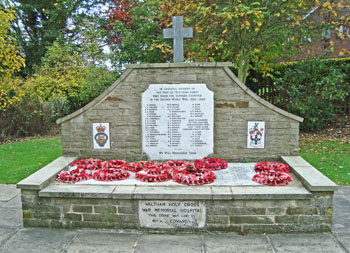
The War Memorial plaques from the Hospital have been relocated in a small park on the corner of Farm Hill Road and Honey Lane.

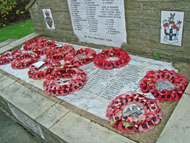
The foundation stone, laid in September 1920 by Mrs A.J. Edwards, is set into the front of the Memorial (left). Waltham Holy Cross Urban District included the town of Waltham Abbey. The Memorial Tablet inscribed with the names of those killed during WW1 lies horizontally on the altar top (right). The tablet with the names of those who died during WW2 has been placed vertically.
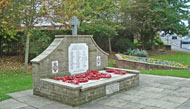
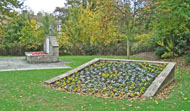
The preserved War Memorial is flanked by banks of flowers. Waltham Abbey Town Council is responsible for the maintenance of the Memorial.
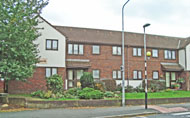
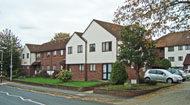
Cobbinsbank now occupies the site of the Hospital.
http://hansard.millbanksystems.com
www.british-history.ac.uk
www.efdhistory.org.uk
www.hertfordshiremercury.co.uk
www.nationalarchives.gov.uk
www.walthamabbeyarchive.com
Return to home page